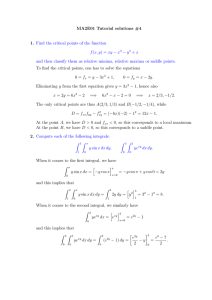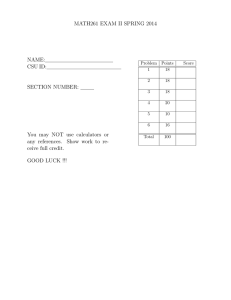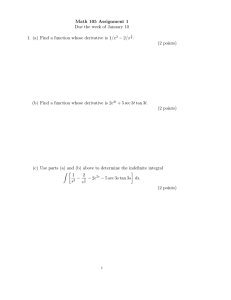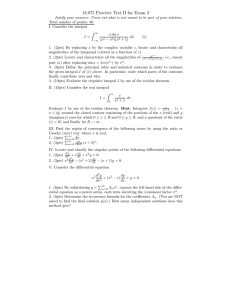1.(6pts) Find dz/dt when t = 0, where z = x 2 + y2 + 2xy, x = ln(t + 1
advertisement
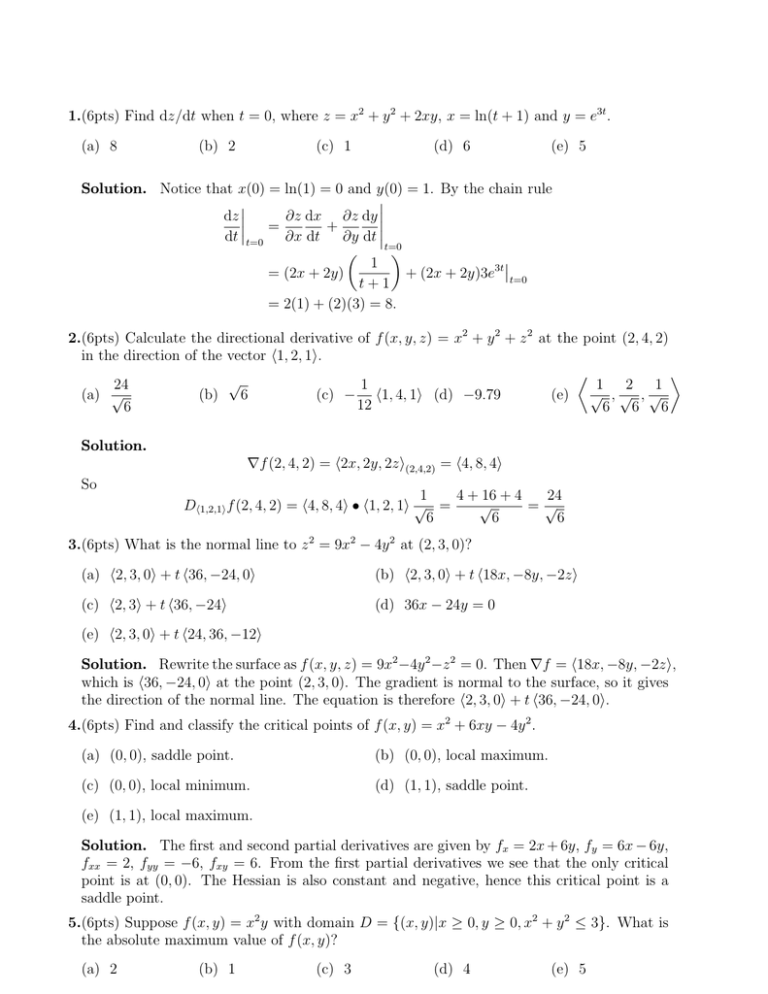
1.(6pts) Find dz/dt when t = 0, where z = x2 + y 2 + 2xy, x = ln(t + 1) and y = e3t .
(a) 8
(b) 2
(c) 1
(d) 6
(e) 5
Solution. Notice that x(0) = ln(1) = 0 and y(0) = 1. By the chain rule
dz ∂z dx ∂z dy +
=
dt t=0 ∂x dt
∂y dt t=0
1
= (2x + 2y)
+ (2x + 2y)3e3t t=0
t+1
= 2(1) + (2)(3) = 8.
2.(6pts) Calculate the directional derivative of f (x, y, z) = x2 + y 2 + z 2 at the point (2, 4, 2)
in the direction of the vector h1, 2, 1i.
√
24
1
1 2 1
(a) √
(b) 6
(c) − h1, 4, 1i (d) −9.79
(e) √ , √ , √
12
6
6 6 6
Solution.
∇f (2, 4, 2) = h2x, 2y, 2zi(2,4,2) = h4, 8, 4i
So
4 + 16 + 4
24
1
√
=√
Dh1,2,1i f (2, 4, 2) = h4, 8, 4i • h1, 2, 1i √ =
6
6
6
3.(6pts) What is the normal line to z 2 = 9x2 − 4y 2 at (2, 3, 0)?
(a) h2, 3, 0i + t h36, −24, 0i
(b) h2, 3, 0i + t h18x, −8y, −2zi
(c) h2, 3i + t h36, −24i
(d) 36x − 24y = 0
(e) h2, 3, 0i + t h24, 36, −12i
Solution. Rewrite the surface as f (x, y, z) = 9x2 −4y 2 −z 2 = 0. Then ∇f = h18x, −8y, −2zi,
which is h36, −24, 0i at the point (2, 3, 0). The gradient is normal to the surface, so it gives
the direction of the normal line. The equation is therefore h2, 3, 0i + t h36, −24, 0i.
4.(6pts) Find and classify the critical points of f (x, y) = x2 + 6xy − 4y 2 .
(a) (0, 0), saddle point.
(b) (0, 0), local maximum.
(c) (0, 0), local minimum.
(d) (1, 1), saddle point.
(e) (1, 1), local maximum.
Solution. The first and second partial derivatives are given by fx = 2x + 6y, fy = 6x − 6y,
fxx = 2, fyy = −6, fxy = 6. From the first partial derivatives we see that the only critical
point is at (0, 0). The Hessian is also constant and negative, hence this critical point is a
saddle point.
5.(6pts) Suppose f (x, y) = x2 y with domain D = {(x, y)|x ≥ 0, y ≥ 0, x2 + y 2 ≤ 3}. What is
the absolute maximum value of f (x, y)?
(a) 2
(b) 1
(c) 3
(d) 4
(e) 5
Solution. Interior: If (x, y) is a critical point, then fy (x, y) = x2 = 0 and (x, y) is not an
interior point.
Boundary: If x = 0 or y = 0, then f (x, y) = 0.
Otherwise, (x, y) is on the √
curved part of the boundary where x2 = 3 − y 2 and f (x, y) =
g(y) = 3y − y 3 with 0 ≤ y ≤√ 3. Since√g 0 (y) = 3 − 3y 2 we get that y = 1 is a critical point
for this problem. Then x = 2 and f ( 2, 1) = 2.
Since the region is closed and bounded, f must have a maximum value and since 2 > 0, 2
is it.
OR
√
Lagrange multipliers: 2xy, x2 = λ h2x, 2yi. One solution is x = 0, hence y = 3, λ = 0.
x
Here f = 0. If x 6= 0, λ = y, 2y 2 = x2 and y = √ (the other solutions are not in the
2
2
2
x
3x
region). Hence x2 +
= 3 or
= 3 so x2 = 2 and at this point f = 2 and as above this
2
2
must be the maximum value.
6.(6pts) Consider the following contour plot for a function f (x, y):
The circle is a level curve g(x, y) = k. Which of the following must ALWAYS be true?
(a) Subject to g(x, y) = k, f (x, y) has a possible extremum at C.
(b) Subject to g(x, y) = k, f (x, y) has a possible maximum at A.
(c) Subject to g(x, y) = k, f (x, y) has a possible minimum at D.
(d) Subject to g(x, y) = k, f (x, y) has an absolute maximum at B.
(e) f (x, y) has a possible absolute maximum or absolute minimum at C.
Solution. At A and at D, ∇f is not parallel to ∇g, so neither A or D can be an extremum
of f subject to g = k. B is a potential extremum of f subject to g = k, but it could be that
B is a absolute minimum, or just a local minimum/maximum. The statement “f (x, y) has a
possible absolute maximum or minimum at C” is wrong since the gradient of f at C is not
zero.
On another note, it is worthwhile to note that the Lagrange multipliers theorem says
nothing about the extrema of f itself, but of f restricted to g = k.
Thus f (x, y), subject to g = k, having a possible extremum at C is the correct answer
since here ∇f is parallel to ∇g and ∇g 6= 0 at C, so this satisfies the hypothesis of the
Lagrange multiplier theorem naming C as a candidate extremum point.
7.(6pts) Evaluate the following double integral
ZZ
(5 − x) dA
R
for R = (x, y) | 0 ≤ x ≤ 4, 0 ≤ y ≤ 3 .
(a) 36
(b) 24
(c) 60
(d) 12
(e) 52
Solution. The region R is a rectangle in the xy-plane, and since z = 5 − x we see that we
are computing the volume of a solid which can be viewed as a rectangular prism with base
R and height 1, together with a (right) triangular prism on top of the rectangular solid with
base R and height 4. So we can compute the integral by computing the volumes of the two
solids and adding.
Volume of the rectangular prism: V = l ∗ w ∗ h = 4 ∗ 3 ∗ 1 = 12
1
1
Volume of the triangular prism: V = l ∗ w ∗ h = 4 ∗ 3 ∗ 4 = 24
2
2
So the total volume is 36.
OR
ZZ
Z 4Z 3
Z 4
Z 4
y=3
(5 − x) dA =
(5 − x) dy dx =
(5 − x) y=0 dx =
(15 − 3x) dx = 15x −
R
0
0
0
0
3x2 x=4
= 60 − 24 = 36.
2 x=0
OR
x=4
ZZ
Z 3Z 4
Z 3
Z 3
x2 (5 − x) dA =
(5 − x) dx dy =
5x −
dy =
(20 − 8) dy =
2 x=0
R
0
0
0
0
Z 3
y=3
12 dy = 12y y=0 = 36.
0
ZZ
8.(6pts) Consider the double integral of a function f over a region R,
Z 3 Z y2
ZZ
f (x, y) dx dy. Which gray region below is R?
f dA =
R
1
f dA. Suppose
R
y
(a)
(b)
(c)
(d)
(e)
Solution. The region R can be described in formulas as the set of all (x, y) such that
1 6 y 6 3 and y 6 x 6 y 2 . There is only one region which lies between y = 1 and y = 3.
9.(10pts) (a) Find an equation for the tangent line (in vector or parametric form) at the point
(2, 2, 1) to the curve of intersection of the two surfaces g(x, y, z) = 2x2 + 2y 2 + z 2 = 17 and
h(x, y, z) = x2 + y 2 − 3z 2 = 5. (8 pts)
(b) Suppose f (x, y, z) is a function with ∇f = h0, 1, 0i at the point (2, 2, 1). Starting at
(2, 2, 1), which direction should one travel along the curve of intersection in order to increase
f ? (2 pts)
Note: You can specify a direction along the curve by saying whether the variable in your
equation from (a) would increase or decrease, or by choosing a vector tangent to the curve.
Solution. (a) The line is in the tangent plane to each surface, so its direction is perpendicular to both normal vectors. The normal vectors are ∇g = h4x, 4y, 2zi = h8, 8, 2i and
∇h = h2x, 2y, −6zi =< 4, 4, −6 >. The cross product ∇g × ∇h = h−56, 56, 0i will serve as
a direction vector. h2, 2, 1i + t h−56, 56, 0i is an equation for the tangent line.
(b) Let u be a unit vector which points in the same direction as h−56, 56, 0i. Since
h0, 1, 0i • h−56, 56, 0i
1
√
Du f =
= √ > 0 at (2, 2, 1), one should increase t in order to
56 2
2
increase f .
10.(10pts) Find the absolute maximum and minimum of f (x, y, z) = 2x + y with respect to the
constraints g(x, y, z) = 2x2 + z 2 = 4 and h(x, y, z) = 2x + y + 3z = 6.
Solution.
∇f = h2, 1, 0i
∇g = h4x, 0, 2zi
∇h = h2, 1, 3i
So
2 = 4xλ + 2µ
1=µ
0 = 2λ + 3µ
Using the second equation on the first equation we get
2 = 4xλ + 2
This reduces to
0 = 4xλ
This implies x = 0 or λ = 0. Let try λ = 0 in the third equation above. That yields
0 = 3 which is a contradiction. So x = 0. Now we can use our restraints to find y, z. Using
g(x, y, z) = 2x2 + z 2 = 4, we get z 2 = 4 or z = ±2. Using h(x, y, z) = 2x + y + 3z = 6 we see
that when x = 0 and z = 2 that y + 6 = 6 so that y = 0 and that when x = 0 and z = −2
that y − 6 = 6 so that y = 12. So our critical points are (0, 0, 2) and (0, 12, 2). f (0, 0, 2) = 0
for an absolute minimum and f (0, 12, −2) = 12 for an absolute maximum.
11.(10pts) Find and classify all critical points of f (x, y) = 3x2 y + y 3 − 3x2 − 3y 2 + 2.
Solution.
Begin by finding all first and second partial derivatives: fx = 6xy − 6x,
fy = 3x2 + 3y 2 − 6y, fxx = 6y − 6, fxy = 6x, fyy = 6y − 6. We now need the critical points.
Find these by solving the equations
fx = 6xy − 6x = 0
fy = 3x2 + 3y 2 − 6y = 0
The first equation factors as 6x(y − 1) = 0 so it will be zero if x = 0 or y = 1. The
most common mistake here was to forget the x = 0 solution. To find the critical points
we can plug these values into fy and solve for the remaining variable. For x = 0 we have
fy = 3y 2 − 6y = 0 which implies y = 0 or y = 2. For y = 1 we have fy = 3x2 − 3 = 0 which
implies x = 1 or x = −1. So if x = 0 we have the critical points (0, 0) and (0, 2). If y = 1
we have the critical points (1, 1) and (−1, 1). Now all we need to do is classify the critical
points. The discriminant D(x, y) is given by
D(x, y) = (6y − 6)2 − 36x2
(0, 0): D(0, 0) = 36 > 0 and fxx (0, 0) = −6 < 0. (0, 2): D(0, 2) = 36 > 0 and fxx (0, 2) =
6 > 0. (1, 1): D(1, 1) = −36 < 0. (−1, 1): D(−1, 1) = −36 < 0. So (0, 0) is a relative max,
(0, 2) is a relative min, and (1, 1), (−1, 1) are saddle points.
12.(10pts) A cylinder containing an incompressible fluid is being squeezed from both ends. If
the length of the cylinder is changing at a rate of −3m/s, calculate the rate at which the
radius is changing when the radius is 2m and the length is 1m. (Note: An incompressible
fluid is a fluid whose volume does not change.)
Solution. We have V = πr2 `, where V is the volume, r the radius and ` the length, and
dV
each of r and ` are functions of the time, t. Since the fluid is incompressible
= 0.
dt
By the chain rule, this is
dV
∂V dr ∂V d`
dr
d`
0=
=
+
= 2πr` + πr2 .
dt
∂r dt
∂` dt
dt
dt
2
Filling in d`/dt = −3 we obtain dr/dt = 3πr /2πr` = 3r/2`. When r = 2, ` = 1 this gives
dr/dt = 3m/s.
ZZ
13.(10pts) Evaluate
y = x3 .
4xy dA where R is the region bounded above by y =
R
√
x and below by
Solution. A picture of the region:
To set up the double integral as an iterated integral dy dx we first need bounds for x.
Clearly
when x = 0 and end when x = 1 or more formally we need to find when
√ we start
3
6
x = x or x = x or x = 0, x5 = 1, which
√ has solutions x = 0, 1. Then the limits on the
inner integral are x3 at √the bottom and x at the top.
1
ZZ
Z 1Z x
Z 1
Z 1
√x
2x3 2x8 2
2
7
−
=
4xy dA =
4xy dy dx =
2xy dx =
2x − 2x dx =
3
8 0
x3
R
0
x3
0
0
2 1
5
− =
3 4
12
Or we could set up the double integral as an iterated integral dx dy. This time we need to
know the y-coordinates of the intersection points but the same algebra as above gives y = 0,
1. The limits on the inner integral start at the right hand curve whose x-coordinate in terms
of y is x√= y 2 . The upper limit is the x-coordinate of the right-han curve in terms of y which
is x = 3 y. Hence
1
Z 1
Z 1
ZZ
Z 1Z √
3y
x= √
3y
3 8/3 2y 6 2 5/3
5
4xy dx dy =
2x y dx =
2y −2y dy = 2 y −
=
4xy dA =
8
6 0
x=y 2
y2
0
0
R
0
3 1
5
− = .
4 3
12
